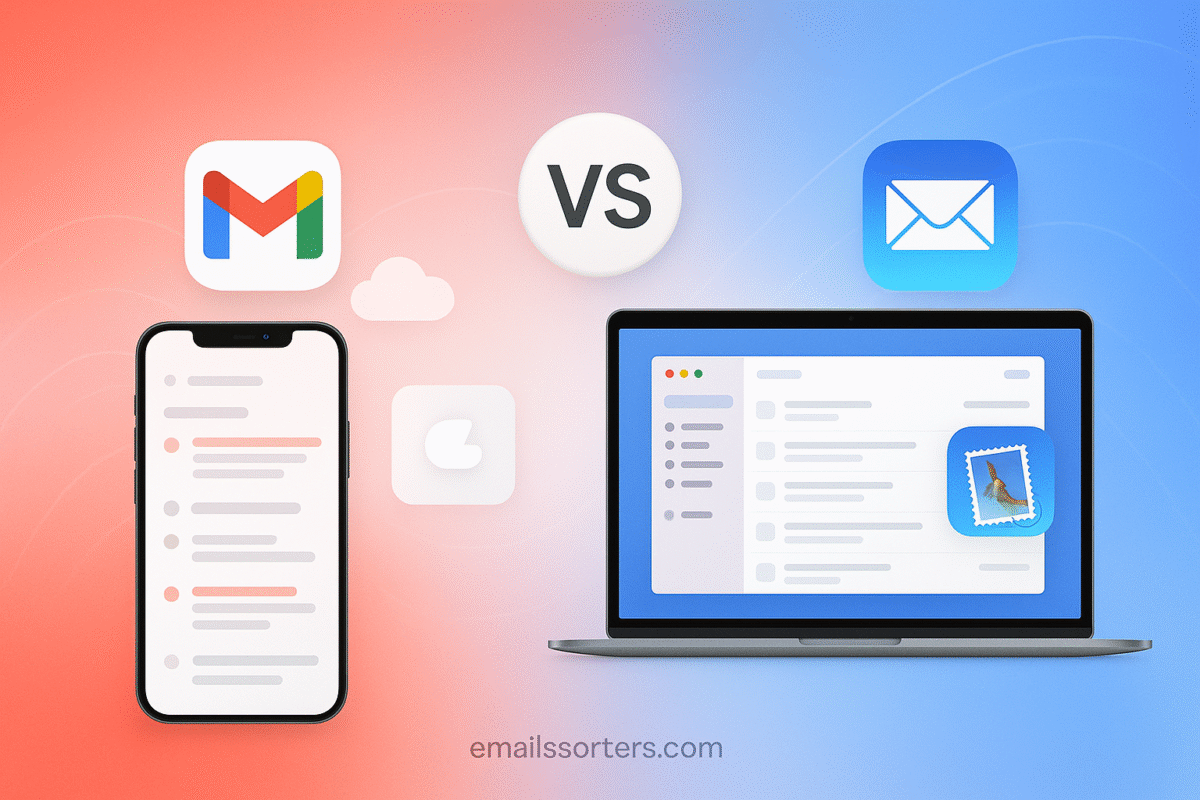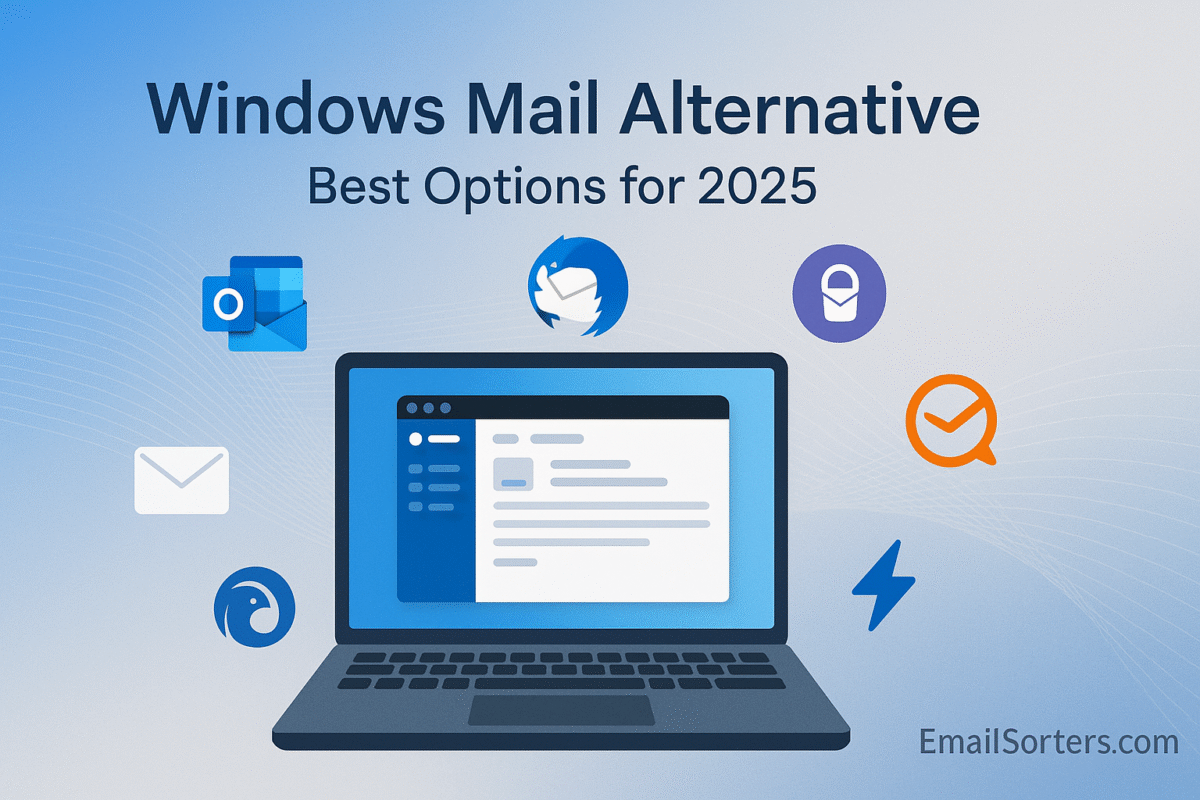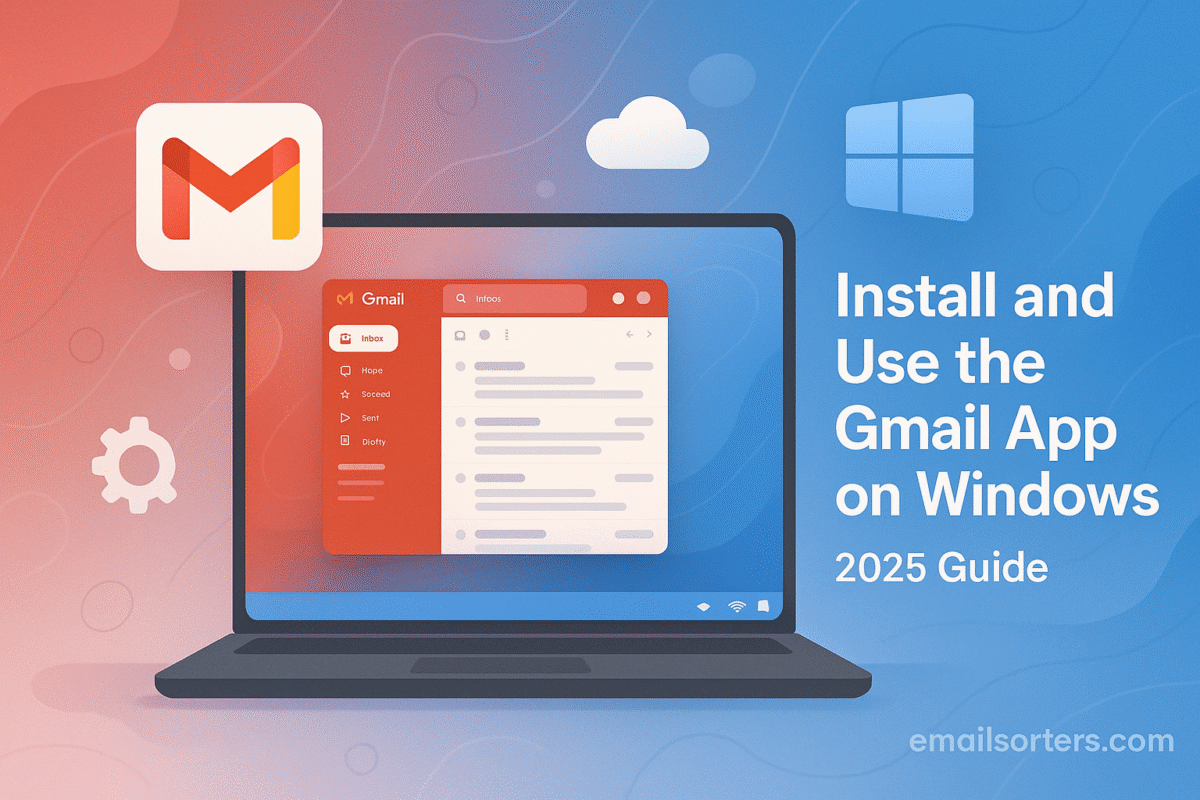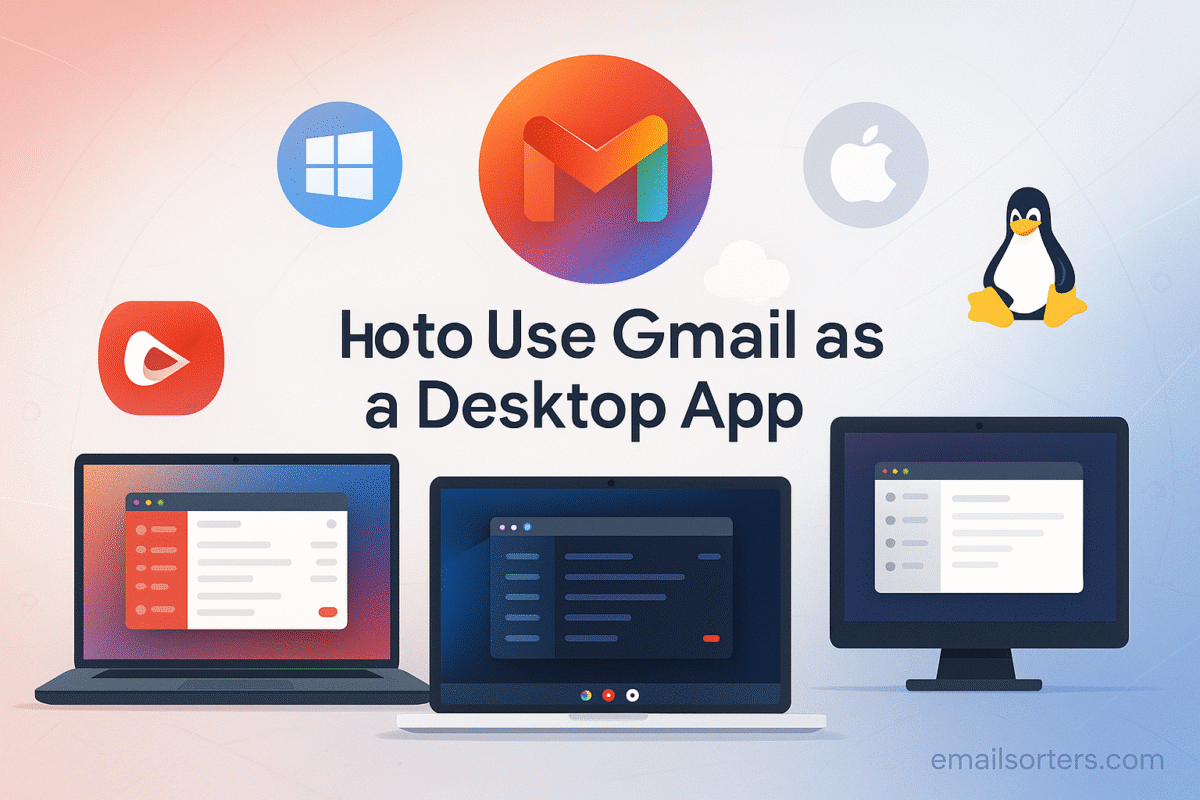Gmail vs Apple Mail is one of the most common comparisons for people choosing an email app in 2025. Email remains a cornerstone of work, school, and personal communication, and the app you use can significantly impact how organized and productive you feel.
Both Gmail and Apple Mail are free, widely used, and feature-rich, but they take very different approaches. Gmail emphasizes cloud-based performance, deep integration with Google services, and accessibility across any device. Apple Mail, by contrast, is built to fit seamlessly into the Apple ecosystem, with a clean interface, native iOS/macOS design, and strong privacy protections.
In this guide, we’ll compare Gmail and Apple Mail side by side. You’ll see how they stack up in terms of design, ease of use, storage, performance, productivity tools, privacy, and cross-platform compatibility. By the end, you’ll know which email app better fits your workflow, whether you prioritize cloud flexibility or Apple’s smooth ecosystem.
Overview of Gmail
History and Background
Gmail launched in 2004 with a bold offer: 1 GB of free storage at a time when most email services offered only a fraction of that. Over the years, it has grown into the world’s most widely used email platform, with billions of active users. Gmail is available as a web app and as mobile apps on Android and iOS.
Key Features and Functionality
Some of Gmail’s standout features include:
- 15 GB of free storage, shared across Google services
- Labels instead of folders, allowing multiple categories per email
- Powerful search engine to find old emails quickly
- Smart Compose and Smart Reply, which suggest responses and predict sentences
- Integration with Google Workspace, including Docs, Drive, and Meet
Gmail also automatically categorizes emails into tabs like Primary, Social, Promotions, and Updates, reducing inbox clutter.
Who Typically Uses Gmail
Gmail appeals to:
- Students who rely on Google Drive and Docs
- Professionals who use Google Meet or Calendar
- People with multiple devices who want a consistent experience everywhere
Its biggest draw is universal accessibility; you can sign in from almost any device and find your inbox exactly as you left it.
Overview of Apple Mail
History and Background
Apple Mail, often simply called “Mail,” has been around since Mac OS X Panther in 2003. It comes pre-installed on every Apple device, from iPhones to MacBooks. Unlike Gmail, Apple Mail isn’t a standalone email service; it’s a client that allows you to connect to email accounts such as iCloud, Gmail, Outlook, Yahoo, and others.
Key Features and Functionality
Apple Mail focuses on simplicity and integration within Apple’s ecosystem. Its key features include:
- Seamless connection to iCloud Mail and other providers
- Smart Mailboxes, which automatically group certain types of emails
- Handoff support, so you can start an email on your iPhone and finish it on your Mac
- Strong privacy features, including blocking invisible tracking pixels
- Deep integration with Siri, making voice commands possible
Unlike Gmail, Apple Mail doesn’t require a separate account if you already use iCloud, making setup easy for Apple users.
Who Typically Uses Apple Mail
Apple Mail appeals to:
- People who primarily use iPhones, iPads, and Macs
- Users who value privacy and a clutter-free design
- Those who prefer a traditional folder-based system over Gmail’s labels
Its main advantage is how naturally it fits into Apple’s overall user experience.
Ease of Use
User Interface Comparison
Gmail’s interface is modern, colorful, and packed with options. Tabs, filters, and labels give you many ways to sort and manage emails. On the other hand, Apple Mail has a cleaner, more minimal design. It looks simple, with a focus on plain text and fewer distractions.
If you like customization and advanced features, Gmail may feel more powerful. If you prefer a straightforward, no-frills layout, Apple Mail might feel easier.
Setup Process for Both Apps
- Gmail: Sign up with a Google account, and you’re ready. If you use multiple accounts, switching between them is quick.
- Apple Mail: Already comes installed on Apple devices. Just sign in with your Apple ID (or any other email account), and the app syncs automatically.
Accessibility Across Devices
- Gmail works on any device with internet access; Android, iOS, Windows, and Mac.
- Apple Mail works best on Apple devices, though you can still add Gmail or Outlook accounts.
For users who switch between different brands of devices, Gmail offers more flexibility.
Design and User Experience
Layout and Customization Options
Gmail gives you the ability to change themes, adjust density (compact, comfortable, or default), and use advanced labels for organization. Apple Mail, while visually clean, offers fewer customization options.
Navigation Differences
- Gmail: Uses labels and categories instead of folders. This lets you tag an email with multiple labels, so it appears in different views.
- Apple Mail: Uses a classic folder approach. Messages go into one folder at a time, making navigation familiar for users of older email programs.
Personalization Features
Gmail allows you to add profile pictures, change your signature, and enable smart features. Apple Mail focuses more on simplicity, offering basic customization without overwhelming users.
Integration with Other Apps and Services
One of Gmail’s biggest advantages is how well it integrates with Google’s ecosystem. If you already use Google Drive, Google Docs, Google Meet, or Google Calendar, Gmail acts as the hub that connects them all. For example, you can attach a file from Google Drive directly within Gmail, schedule a meeting through Google Calendar from the same window, or join a Google Meet call with a single click. This level of connectivity makes Gmail especially appealing for people who work in teams, students collaborating on projects, or professionals managing multiple tasks at once.
Apple Mail, by contrast, integrates smoothly with Apple’s ecosystem. If you use iCloud Mail, Contacts, Calendar, and Notes, Apple Mail ties them together in a clean and efficient way. Starting an email on your iPhone and finishing it on your Mac is seamless through Handoff. Files saved in iCloud Drive can easily be attached to emails, and Siri can help draft or read messages aloud. The app does not try to overwhelm users with options but instead focuses on making the Apple experience more cohesive.
When it comes to third-party compatibility, Gmail has the upper hand because it works well across different platforms and apps, including Microsoft Outlook, Slack, and Zoom. Apple Mail does support multiple email providers but is designed first and foremost for Apple’s own services. If you own only Apple devices, the difference may feel small, but for users juggling a mix of platforms, Gmail usually provides a smoother workflow.
Performance and Speed
Performance is one of the most important factors in choosing an email app. Gmail is known for its speed and reliability, largely because it runs on Google’s servers. Emails load quickly, searches are almost instant, and attachments open without delay as long as you have an internet connection. Google has fine-tuned Gmail to handle large volumes of mail without slowing down, making it a favorite for people who deal with hundreds of emails daily.
Apple Mail takes a slightly different approach. Because it downloads and caches emails on your device, messages can sometimes load faster after the initial sync, especially when you revisit the same email multiple times. This offline caching is particularly useful when traveling or when internet access is limited. On the downside, the first time Apple Mail syncs a large mailbox, the process can take a while, and it may consume more storage on your device compared to Gmail.
Handling large attachments also sets the two apart. Gmail allows attachments up to 25 MB and automatically uses Google Drive for anything larger. Apple Mail, while supporting similar limits, often depends on iCloud for larger files. The difference here depends on whether you prefer storing files in Google Drive or iCloud. In practice, both apps are fast, but Gmail’s cloud-first approach makes it slightly more reliable for people with constant access to the internet, while Apple Mail’s local caching shines when offline access is needed.
Security and Privacy
Security and privacy are areas where many users draw the line when choosing between Gmail and Apple Mail. Gmail provides strong security features, including two-factor authentication, spam detection, phishing alerts, and automatic virus scanning of attachments. Google constantly updates its systems to block malicious content, which is a major reason why Gmail is considered safe by millions of users worldwide.
That said, Google does analyze email content to improve spam filters and provide smart features like predictive typing. While this process is automated and not read by humans, some users feel uneasy about their data being processed in this way.
Apple Mail takes a more privacy-focused stance. It does not scan your emails for advertising or predictive purposes. One standout feature is Mail Privacy Protection, which blocks invisible tracking pixels that marketers often use to see when and where you open their emails. This means Apple Mail users can read emails without sharing as much personal data. For Apple users who value privacy above all else, this can be a major reason to stick with Apple Mail.
Storage and File Handling
Storage is another key difference between the two apps. Gmail offers 15 GB of free storage, which is shared across Gmail, Google Drive, and Google Photos. Once you exceed that limit, you’ll need to purchase a Google One plan. While 15 GB may sound like a lot, it can fill up quickly if you receive frequent attachments or store large files in Google Drive.
Apple Mail itself does not provide storage, but if you use iCloud Mail, you get 5 GB of free space, which also covers iCloud backups, photos, and other files. Many users find this limit restrictive and end up subscribing to a paid iCloud storage plan. Because Apple Mail downloads emails locally, the storage burden often shifts to your device, which can eat into your iPhone or Mac’s available memory if your inbox is large.
For handling attachments, Gmail again leans on Google Drive, letting you send or receive large files with ease. Apple Mail does the same with iCloud Drive but is more restrictive with free storage. The best choice here depends on whether you prefer Google’s or Apple’s cloud system. For heavy email users, Gmail’s larger free storage allocation usually feels more generous.
Spam Filtering and Email Management
Spam filtering is an area where Gmail has built a strong reputation. Its automatic spam detection is among the best in the industry, often catching unwanted messages before they reach your inbox. Emails identified as spam go into a separate folder, and the system continues to learn from user feedback, making it smarter over time. The tabbed inbox system also helps by automatically sorting promotional emails and social updates, so your primary inbox stays focused on important messages.
Apple Mail also offers solid spam filtering, but much of the heavy lifting depends on your email provider rather than the app itself. If you connect Gmail or Outlook accounts to Apple Mail, you’ll still benefit from those providers’ spam filters. Apple Mail does provide a junk folder and allows you to create custom rules to filter emails, but it doesn’t match Gmail’s proactive categorization.
When it comes to email management, Gmail’s labels, filters, and search capabilities are powerful tools. You can tag a single email with multiple labels, making it easier to find later. Apple Mail relies on a more traditional folder system, which feels familiar but less flexible. While both apps help you manage clutter, Gmail’s system tends to scale better for users with heavy email traffic.
Customization and Personalization
Customization is one area where Gmail and Apple Mail take noticeably different approaches. Gmail provides a variety of ways to make the inbox feel like your own. You can choose from different themes, adjust the density of your message list, and set multiple inbox configurations. Its system of labels allows for flexible organization, letting one message appear under several categories at once. This approach is especially useful for people who manage work, personal, and project-related emails within the same account.
Apple Mail, in contrast, values simplicity over deep customization. The app maintains a clean and minimal look that aligns with Apple’s overall design philosophy. Users can set up custom signatures, choose how messages are displayed, and create rules for sorting emails into folders, but beyond that, the options are limited. For many people, this stripped-down approach is a plus; it keeps the interface uncluttered and easy to navigate. But for users who enjoy tailoring every detail of their workspace, Gmail usually feels more satisfying.
Another difference lies in smart features. Gmail suggests responses and predicts text as you type, saving time for those who reply to many emails each day. Apple Mail avoids these predictive tools, sticking with a more straightforward typing experience. This distinction often comes down to personal preference: some users appreciate Gmail’s efficiency, while others prefer Apple Mail’s distraction-free simplicity.
Cross-Platform Compatibility
Cross-platform use is where Gmail clearly shines. Because Gmail is web-based, you can log in from nearly any device with an internet connection; whether it’s a Windows computer, Android phone, iPad, or even a shared computer at a library. The experience remains consistent across devices, with your emails, labels, and settings always in sync. The dedicated Gmail apps for iOS and Android also ensure smooth performance on mobile devices.
Apple Mail, by comparison, is tightly tied to Apple’s ecosystem. It is pre-installed on iPhones, iPads, and Macs, but not available for Windows or Android. If you own only Apple devices, this limitation may not matter, since Apple Mail provides a smooth and cohesive experience across your gadgets. But for anyone who switches between Apple and non-Apple devices, the lack of cross-platform support can be frustrating.
It’s worth noting that while Apple Mail itself is not available outside of Apple hardware, you can still access iCloud Mail through a web browser. This provides a workaround but does not offer the same functionality or polish as the native Mail app. For users who demand universal access and consistency across devices, Gmail is the more practical choice.
Productivity Features
When it comes to boosting productivity, Gmail offers several standout tools. Its search function is fast and highly accurate, allowing users to find even years-old emails by keyword, sender, or date. Labels and filters make organizing incoming mail almost automatic, so you spend less time sorting messages manually. Gmail also connects seamlessly with Google Calendar, making it easy to schedule events directly from an email invitation. Features like Smart Compose and Smart Reply further save time, suggesting quick responses or even drafting sentences as you type.
Apple Mail approaches productivity differently. Instead of overwhelming users with options, it focuses on straightforward organization. Smart Mailboxes, for example, allow you to create custom views that automatically gather emails meeting certain conditions, such as unread messages or messages from specific senders. Rules can also be set up to file emails into folders automatically. While these tools are effective, they require a bit of manual setup compared to Gmail’s automated sorting.
Another distinction is in collaboration. Gmail’s deep integration with Google Docs, Sheets, and Meet makes it a natural choice for team projects and group communications. Apple Mail, while excellent for managing individual correspondence, does not provide the same level of built-in collaboration features. For personal use or light professional communication, Apple Mail works well. But for busy professionals juggling meetings, shared documents, and multiple email threads, Gmail typically feels more powerful.
Offline Access
Offline access can make a big difference for people who travel often or live in areas with spotty internet connections. Gmail offers an offline mode that lets you read, respond to, and search emails without a connection. Once you reconnect, your actions sync automatically. This feature is especially useful for business travelers or anyone who relies heavily on email during flights or commutes.
Apple Mail handles offline access in a more traditional way. Because the app downloads and stores emails locally, you can usually read and respond to messages even when you’re offline. Drafted emails are saved and sent once the device reconnects. This method is straightforward and reliable, though it requires local storage space on your device.
The difference often comes down to personal preference. Gmail’s offline mode requires enabling through settings, but once set up, it works smoothly. Apple Mail provides offline access by default, as long as your device has already synced the mailbox. Both options are effective, but Apple Mail’s system feels more natural for users who value instant offline availability without toggling extra settings.
Which One is Right for You?
Choosing between Gmail and Apple Mail depends on your habits, devices, and priorities. If you’re a student or a professional who often collaborates with others, Gmail is usually the better option. Its strong integration with Google Docs, Sheets, Drive, and Meet makes working in groups smooth and convenient. The tabbed inbox, labels, and powerful search features also help manage large volumes of emails efficiently.
For professionals in business settings, Gmail provides flexibility across different platforms. If you work on a mix of devices; perhaps a Windows computer in the office and an iPhone on the go; Gmail ensures a consistent experience everywhere. Features like two-factor authentication and phishing alerts also give an added layer of security, making it a reliable choice for sensitive communication.
Apple Mail, on the other hand, is the natural pick for people deeply invested in Apple’s ecosystem. If you own an iPhone, iPad, and MacBook, Apple Mail ties everything together without the need to install extra apps. The simple, uncluttered design suits users who prefer a straightforward experience, while privacy features like Mail Privacy Protection make it a strong choice for those concerned about data tracking.
For casual users who don’t deal with hundreds of emails a day, Apple Mail’s minimalism might be exactly what they need. It does the basics well, keeps distractions away, and makes managing an inbox stress-free. Ultimately, Gmail is the winner for flexibility and advanced features, while Apple Mail excels in simplicity and privacy.
Conclusion
Both Gmail and Apple Mail are excellent email apps, but they cater to different needs. Gmail stands out for its cross-platform support, deep integration with Google services, and advanced tools for managing busy inboxes. It’s a strong choice for students, professionals, and anyone who values productivity.
Apple Mail focuses on a clean, distraction-free interface and strong privacy protections. It is best for people who primarily use Apple devices and want an email app that blends smoothly into their existing setup. Its offline access and simplicity make it reliable without overwhelming users with too many options.
The choice comes down to what matters most to you: Gmail if you want power and flexibility, Apple Mail if you prefer simplicity and privacy.
FAQs
1. Can I use Gmail inside Apple Mail?
Yes. You can add a Gmail account to Apple Mail by signing in with your Google credentials. This allows you to manage Gmail through Apple Mail’s interface, though you won’t have access to some Gmail-specific features like labels.
2. Does Apple Mail work with non-Apple email addresses?
Absolutely. Apple Mail supports email accounts from Gmail, Outlook, Yahoo, and many other providers. You simply add the account in the app’s settings.
3. Which app has better spam protection?
Gmail is generally stronger at filtering spam, thanks to Google’s advanced algorithms. Apple Mail relies more on the spam detection of your email provider, though you can set rules for additional filtering.
4. Can I switch from Gmail to Apple Mail easily?
Yes. Since Apple Mail can connect to Gmail, you can view and manage your Gmail inbox through the Mail app without losing any data. The transition is simple and doesn’t require migrating emails manually.
5. Which one uses less storage on my phone?
Gmail stores most of its data in the cloud, so it typically uses less local storage. Apple Mail downloads emails to your device, which can consume more space if you have a large inbox.




